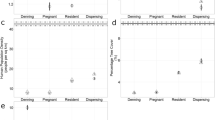Abstract
The ideal free distribution assumes that habitat selection is without cost and predicts that fitness should be equal in different habitats. If habitat selection has a cost, then individuals should only move to another habitat when potential fitness in the new habitat exceeds that in the source habitat by an amount greater than the cost of habitat selection. We used isodar techniques to assess the cost of habitat selection. In an experimental landscape, we monitored density, movement, and reproductive success of adult female prairie voles, Microtus ochrogaster, in adjacent paired habitats with low and high cover. We tested the following hypotheses: (1) adult female prairie voles exhibited density-dependent habitat selection; (2) the cost of habitat selection was density-independent. Habitat quality based on population density and fitness of adult females was higher in high cover habitats. Net movement was from low cover to high cover habitats. The results indicated that adult female prairie voles exhibited density-dependent habitat selection. Furthermore, there was a significant cost of habitat selection, and the cost was density-independent.
Similar content being viewed by others
References
Abrahams, M.V. (1986) Patch choice under perceptualconstraints: a cause for departure from the idealfree distribution. Behav. Ecol. Sociobiol. 19, 409–415.
Anderson, P.K. (1989) Habitat Selection in Rodents: A Resident Fitness Hypothesis. Special publication no. 9, The American Society of Mammalogists, Provo, UT.
Astrom, M. (1994) Travelcost and the idealfree distribution. Oikos 69, 516–519.
Beddington, J.R. (1975) Mutual interference between parasites or predators and its effect on searching efficiency. J. Anim. Ecol. 44, 331–340.
Bernstein, C., Kacelnik, A. and Krebs, J.R. (1988) Individual decisions and the distribution of predators in a patchy environment. J. Anim. Ecol. 57, 1007–1026.
Bernstein, C., Kacelnik, A. and Krebs, J.R. (1991) Individual decisions and the distribution of predators in a patchy environment. II. The influence of travelcosts and structure of the environment. J. Anim. Ecol. 60, 205–225.
Boonstra, R. (1985) Demography of Microtus pennsylvanicus in southern Ontario, enumeration versus Jolly-Seber estimation compared. Can. J. Zool. 63, 1174–1180.
Brown, J.L. (1969) The buffer effect and productivity in tit populations. Am. Nat. 103, 347–354.
Cochran, G.R. and Solomon, N.G. (2000) Effects of food supplementation on the social organization of prairie voles (Microtus ochrogaster). J. Mammal. 81, 746–757.
Desy, E.A. and Batzli, G.O. (1989) Effects of food availability and predation on prairie vole demography: a field experiment. Ecology 70, 411–421.
Fretwell, S.D. and Lucas, H.L. (1970) On territorial behavior and other factors influencing habitat distribution in birds. I. Theoretical development. Acta Biotheor. 19, 16–36.
Getz, L.L. and Hofmann, J.E. (1986) Social organization in free-living prairie voles, Microtus ochrogaster. Behav. Ecol. Sociobiol. 18, 175–282.
Getz, L.L. and McGuire, B. (1997) Communalnesting in prairie voles (Microtus ochrogaster): formation, composition, and persistence of communalgroups. Can. J. Zool. 75, 525–534.
Gillis, D.M. and Kramer, D.L. (1987) Ideal interference distributions: population density and patch use by zebra fish. Anim. Behav. 35, 1875–1882.
Halama, K.J. and Dueser, R.D. (1994) Of mice and habitats: test for density-dependent habitat selection. Oikos 69, 107–114.
Korona, R. (1990) Travel costs and ideal free distribution of ovipositing female flour beetles, Tribolium confusum. Anim. Behav. 40, 186–187.
Krebs, J.R. (1971) Territory and breeding density in the great tit Parus major L. Ecology 52, 2–22.
Lin, Y.K. (1999) The effects of food, cover and competition on demography, dispersal and density of voles. PhD. Thesis, University of Illinois at Urbana, Champaign.
Lin, Y.K. and Batzli, G.O. (2001) The influence of habitat quality on dispersal, demography, and population dynamics of voles. Ecol. Monogr. 71, 245–275.
Messier, F., Virgil, J.A. and Marinelli, L. (1990) Density-dependent habitat selection in muskrats: a test of the ideal free distribution model. Oecologia 84, 380–385.
Morris, D.W. (1987) Spatial scale and the cost of density-dependent habitat selection. Evol. Ecol. 1, 379–388.
Morris, D.W. (1988) Habitat-dependent population regulation and community structure. Evol. Ecol. 2, 253–269.
Morris, D.W. (1989) Density-dependent habitat selection: testing the theory with fitness data. Evol. Ecol. 3, 80–94.
Morris, D.W. (1991) Fitness and patch selection by white-footed mice. Am. Nat. 138, 702–716.
Morris, D.W. (1992) Scales and costs of habitat selection in heterogeneous landscapes. Evol. Ecol. 6, 412–432.
Morris, D.W., Lundberg, P. and Ripa, J. (2001) Hamilton's rule confronts ideal-free habitat selection. Proc. R. Soc. Lond. B. 268, 921–924.
Palmqvist, E., Lundberg, P. and Jonzen, N. (2000) Linking resource matching and dispersal. Evol. Ecol. 14, 1–12.
Rosenzweig, M.L. (1991) Habitat selection and population interactions: the search for mechanism. Am. Nat. 137, S5–S28.
Ruxton, G.D. and Rohani, P. (1998) Fitness-dependent dispersalin metapopulations and its consequences for persistence and synchrony. J. Anim. Ecol. 67, 530–539.
Sokal, R.R. and Rohlf, F.J. (1995) Biometry, Freeman, New York.
Sutherland, W.J. (1983) Aggregation and the ‘ideal free’ distribution. J. Anim. Ecol. 52, 821–828.
Sutherland, W.J. (1996) From Individual Behavior to Population Ecology. Oxford University Press, Oxford, UK.
Travis, J.M., Murrell, D.J. and Dytham, C. (1999) The evolution of density-dependent dispersal. Proc. R. Soc. Lond. B 266, 1837–1842.
Wahlstrom, L.K. and Kjellander, P. (1995) Ideal free distribution and natal dispersal in female roe deer. Oecologia 103, 302–308.
Author information
Authors and Affiliations
Corresponding author
Rights and permissions
About this article
Cite this article
Lin, YT.K., Batzli, G.O. The cost of habitat selection in prairie voles: an empirical assessment using isodar analysis. Evolutionary Ecology 16, 387–397 (2002). https://doi.org/10.1023/A:1020216502620
Issue Date:
DOI: https://doi.org/10.1023/A:1020216502620




